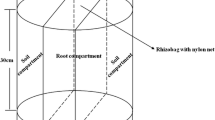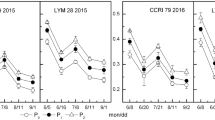Abstract
A rhizobox experiment was conducted to examine the P acquisition characteristics of cotton (Gossypium hirsutum L.), wheat (Triticum aestivum L.) and white lupin (Lupinus albus L.) under P-deficient conditions. We aimed to identify whether cotton is physiologically efficient at acquiring P through release of protons, phosphatases or carboxylates. Plants were pre-grown in the upper compartment of rhizoboxes filled with a sand and soil mixture to create a dense root mat against a 53 μm polyester mesh. For each species, two P treatments (0 and 20 mg P kg−1) were applied to the upper compartment in order to create P-deficient and P-sufficient plants. At harvest, the upper compartment with intact plants was used for collection of root exudates while the lower soil compartment was sliced into thin layers (1 mm) parallel to the rhizoplane. Noticeable carboxylates release was only detected for white lupin. All P-deficient plants showed a capacity to acidify their rhizosphere soil to a distance of 3 mm. The activity of acid phosphatase was significantly enhanced in the soil-root interfaces of P-stressed cotton and wheat. Under P-deficient conditions, the P depletion zone of cotton from the lower soil compartment was narrowest (<2 mm) among the species. Phosphorus fractionation of the rhizosphere soil showed that P utilized by cotton mainly come from NaHCO3–Pi and NaOH–Po pools while wheat and white lupin markedly depleted NaHCO3–Pi and HCl–P pools, and the depletion zone extended to 3 mm. Wheat also depleted NaOH–Po to a significant level irrespective of P supply. The study suggests that acquisition of soil P is enhanced through P mobilization by root exudates for white lupin, and possibly proton release and extensive roots for wheat under P deficiency. In contrast, the P acquisition of cotton was associated with increased activity of phosphatases in rhizosphere soil.





Similar content being viewed by others
References
Bertrand I, Hinsinger P, Jaillard B, Arvieu JC (1999) Dynamics of phosphorus in the rhizosphere of maize and rape grown on synthetic, phosphated calcite and goethite. Plant Soil 211:111–119
Bhadoria PBS, Singh S, Claassen N (2001) Phosphorous efficiency of wheat, maize and groundnut grown in low phosphorous-supplying soil. In: Horst WJ et al (ed) Plant nutrition: food security and sustainability of agro-ecosystem through basic and applied research. Kluwer, Dordrecht, pp 530–531
Braum SM, Helmke PA (1995) White lupin utilizes soil phosphorus that is unavailable to soybean. Plant Soil 176:95–100
Bronson KF, Onken AB, Booker JD, Lascano RJ, Provin TL, Torbert HA (2001) Irrigated cotton yields as affected by phosphorus fertilizer and landscape position. Commun Soil Sci Plant Anal 32:1959–1967
Cakmak I, Marschner H (1990) Decrease in nitrate uptake and increase in proton release in zinc deficient cotton, sunflower and buckwheat plants. Plant Soil 129:261–268
Chen CR, Condron LM, Davis MR, Sherlock RR (2002) Phosphorus dynamics in the rhizosphere of perennial ryegrass (Lolium perenne L.) and radiata pine (Pinus radiata D. Don). Soil Biol Biochem 34:487–499
Chen ZL, Jin XY, Wang QP, Lin YM, Gan L, Tang CX (2007) Confirmation and determination of carboxylic acids in root exudates using LC–ESI–MS. J Sep Sci 30:2440–2446
Curtin D, Wen G (2004) Plant cation-anion balance as affected by the ionic composition of the growing medium. Plant Soil 267:109–115
Dorahy CG, Rochester IJ, Blair GJ (2004) Response of field-grown cotton (Gossypium hirsutum L.) to phosphorus fertilisation on alkaline soils in eastern Australia. Aust J Soil Res 42:913–920
Funderburg E, Kovar J, Smith C, Elston R (1996) A comparison of three soil test P extractants on an alkaline Lousiana soil. In Proceedings of the 1996 Beltwide Cotton Conference, pp 1428–1429
Gahoonia TS, Nielsen NE (1998) Direct evidence on participation of root hairs in phosphorus (32P) uptake from soil. Plant Soil 198:147–152
George TS, Gregory PJ, Robinson JS, Buresh RJ (2002a) Changes in phosphorus concentrations and pH in the rhizosphere of some agroforestry and crop species. Plant Soil 246:65–73
George TS, Gregory PJ, Wood M (2002b) Phosphatase activity and organic acids in the rhizosphere of potential agroforestry species and maize. Soil Biol Biochem 34:1487–1494
George TS, Turner BL, Gregory PJ, Cade-Menun BJ, Richardson AE (2006) Depletion of organic phosphorus from oxisols in relation to phosphatase activities in the rhizosphere. Eur J Soil Sci 57:47–57
Gilbert GA, Knight JD, Vance CP, Allan DL (1999) Acid phosphatase activity in phosphorus-deficient white lupine roots. Plant Cell Environ 22:801–810
Guppy CN, Menzies NW, Moody PW, Compton BL, Blamey FPC (2000) A simplified sequential phosphorus fractionation method. Commun Soil Sci Plant Anal 31:1981–1991
Hedley MJ, Nye PH, White RE (1982) Plant-induced changes in the rhizosphere of rape (Brassica napus var. Emerald) seedlings. II. Origin of the pH change. New Phytol 91:31–44
Hinsinger P, Plassard C, Tang CX, Jaillard B (2003) Origin of root-mediated pH changes in the rhizosphere and their responses to environmental constraints-a review. Plant Soil 248:43–59
Hoffland E (1992) Quantitative evaluation of the role of organic acid exudation in the mobilisation of rock phosphate by rape. Plant Soil 140:279–289
Hoffland E, Findenegg GR, Nelemans JA (1989) Solubilization of rock phosphate by rape. II. Local root exudation of organic acids as a response to P-starvation. Plant Soil 113:161–165
Hylander LD, Ae N, Hatta T, Sugiyama M (1999) Exploitation of K near roots of cotton, maize, upland rice, and soybean grown in an ultisol. Plant Soil 208:33–41
Isbell RF (2002) The Australian soil classification (revised edition). CSIRO, Collingwood, Victoria
Jones DL, Darrah PR (1994) Amino-acid influx at the soil-root interface of Zea mays L. and its implications in the rhizosphere. Plant Soil 163:1–12
Kirk GJD, Van Du L (1997) Changes in rice root architecture, porosity, and oxygen and proton release under phosphorus deficiency. New Phytol 135:191–200
Lambers H, Shane MW, Cramer MD, Pearse SJ, Veneklaas EJ (2006) Root structure and functioning for efficient acquisition of phosphorus: matching morphological and physiological traits. Ann Bot 98:693–713
Lamont BB, Brown G, Mitchell DT (1984) Structure, environmental effects on their formation, and function of proteoid roots in Leucadendron Laureolum (Proteaceae). New Phytol 97:381–390
Li M, Shinano T, Tadano T (1997) Distribution of exudates of lupin roots in the rhizosphere under phosphorous deficient conditions. Soil Sci Plant Nutri 43:237–245
Lynch JP, Brown KM (2001) Topsoil foraging-an architectural adaptation of plants to low phosphorus availability. Plant Soil 237:225–237
Maqsood AG, Sabir M, Ashraf S, Rahmaullah, Aziz T (2005) Effect of P-stress on growth, phosphorus uptake and utilization efficiency of different cotton cultivars. Pakistan J Agric Sci 42:42–47
Marcuswyner L, Rains DW (1982) Nutritional disorder of cotton plants. Commun Soil Sci Plant Anal 13:685–736
Moorby H, Nye PH, White RE (1985) The influence of nitrate nutrition on H+ efflux by young rape plants. Plant Soil 84:403–413
Moorby H, White RE, Nye PH (1988) The influence of phosphate nutrition on H+ efflux from the roots of young rape plants. Plant Soil 105:247–256
Motomizu S, Wakimoto T, Toei K (1980) Spectrophotometric determination of phosphate in river waters with molybdate and malachite green. Analyst 108:361–367
Neumann G, Römheld V (1999) Root excretion of carboxylic acids and protons in phosphorus-deficient plants. Plant Soil 211:121–130
Nuruzzaman M, Lambers H, Bolland MDA, Veneklaas EJ (2006) Distribution of carboxylates and acid phosphatase and depletion of different phosphorus fractions in the rhizosphere of a cereal and three grain legumes. Plant Soil 281:109–120
Pessarakli M (1999) Handbook of plant and crop stress. Marcel Dekker, New York, p 1276
Reuter DJ, Robinson JB (1997) Plant analysis: an interpretation manual. CSIRO, Collingwood, Victoria, p 572
Rowland AP, Haygarth PM (1997) Determination of total dissolved phosphorus in soil solution. J Environ Qual 26:410–415
Sas L, Rengel Z, Tang C (2001) Excess cation uptake, and extrusion of protons and organic acid anions by Lupinus albus under phosphorus deficiency. Plant Sci 160:1191–1198
Shen J, Rengel Z, Tang C, Zhang F (2003) Role of phosphorus nutrition in development of cluster roots and release of carboxylates in soil-grown Lupinus albus. Plant Soil 248:199–206
Tabatabai MA, Bremner JM (1969) Use of p-nitrophenyl phosphate for assay of soil phophatase activity. Soil Biol Biochem 1:301–307
Tang C, Unkovich MJ, Bowden JW (1999) Factors affecting soil acidification under legumes Ш. Effects of nitrate supply. New Phytol 143:513–521
Tang C, Qiao YF, Han XZ, Zheng SJ (2007) Genotypic variation in phosphorus utilization of soybean [Glycine max (L) Murr.] grown in various sparingly soluble P sources. Aust J Agric Res 58:443–451
Thomson BD, Bell RW, Bolland MDA (1992) Low seed phosphorus concentration depresses early growth and nodulation of narrow-leafed lupin (Lupinus angustifolius cv. Gungurru). J Plant Nutrition 15:1193–1214
Veneklaas EJ, Stevens J, Cawthray GR, Turner S, Grigg AM, Lambers H (2003) Chickpea and white lupin rhizosphere carboxylates vary with soil properties and enhance phosphorus uptake. Plant Soil 248:187–197
Vu DT, Tang C, Armstrong RD (2008) Changes and availability of P fractions following 65 years of P application in a calcareous soil in a Mediterranean region. Plant Soil 304:21–33
Watt M, Evans JR (2003) Phosphorus acquisition from soil by white lupin (Lupinus albus L.) and soybean (Glycine max L.), species with contrasting root development. Plant Soil 248:271–283
Acknowledgement
We gratefully acknowledge the financial support from La Trobe University and Cotton Research and Development Corporation. We thank Dr ZL Chen at the University of South Australia for analyzing root exudates.
Author information
Authors and Affiliations
Corresponding author
Additional information
Responsible Editor: Tim Simon George.
Rights and permissions
About this article
Cite this article
Wang, X., Tang, C., Guppy, C.N. et al. Phosphorus acquisition characteristics of cotton (Gossypium hirsutum L.), wheat (Triticum aestivum L.) and white lupin (Lupinus albus L.) under P deficient conditions. Plant Soil 312, 117–128 (2008). https://doi.org/10.1007/s11104-008-9589-1
Received:
Accepted:
Published:
Issue Date:
DOI: https://doi.org/10.1007/s11104-008-9589-1




